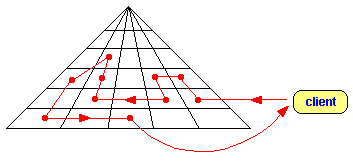|
navigation
consulting
services
training
services
specials
reading
material
resources
|
In the old-world style the focus is on activities.
Old-world principles are based on fragmentation and specialisation. Following Adam Smith criteria, whole processes have been broken-up in a number of activities (fragmentation) - activities have been assigned (as task) to specialised workers, or machines, or units, or functions, or roles (specialisation).
Adam Smith criteria were very valid in the old-world. A static, predictable, efficiency-based, mass oriented world, where monsters were still asleep.....
The traditional, old-world approach to improvement has focused on activities, attempting to increase their efficiency. Whole works have been fragmented and specialised roles and tasks have been created just to maximise activities' efficiency.
The entire old-world is based on specialisation, at all levels. Roles/position like machine setter, welder, mason, painter, bank teller and typist are well representative of this phenomenon.
Specialised, dedicated machines, tools and technologies have been invented for the purpose.
Traditional, mechanised assembly lines are well representative of this phenomenon.
But: fragmented, specialised activities require a system behind. A system that plans them, co-ordinates them, controls them and tries to make some sense of the overall set-up.
In the old-world, the system has been built with the very same criteria of fragmentation and specialisation.
Departments, functions, and associated roles have been invented. Management has been structured accordingly.
So that, in the traditional enterprise, we find a Production Department, a Commercial Department, an Administrative Department, etc.
A Department may be possibly broken-up into sub-departments. In a Factory for instance, we may find a Raw Materials Department, a Primary Cutting Department, a Milling Department...... or, in an Insurance Company, the Underwriting Department, the Claims Department, the Assessing Department......
A typical feature of this system is levels. The overall planning and control set-up is sub-divided in vertical levels, according to the degree of authority (or power), of "responsibility" and of decision-making authority.
Another possible feature of such a system is bureaucracy: to set rules and to ensure respect of the rules - and to control the overall decision-making set-up....
 The net, old-world result is the traditional pyramid, split per function and in levels. The net, old-world result is the traditional pyramid, split per function and in levels.
Possible features are: the white space phenomenon (or blank areas between departmental areas), often degenerating into a black hole situation (nobody taking care of something important) - and the island phenomenon (attention to a particular department at a particular level, loosing "touch" with surrounding areas).
Due to the above, issues are often resolved at the top of the pyramid (bureaucracy).
The main possible problem is: (lack of) communication, with consequential lack of co-ordination and loss of overall momentum.
Generally, this system is very complex and even dangerous in respect of the overall enterprise's performance.
But the main drawback associated with the traditional pyramid is still the process fragmentation.
 In fact it is well possible (and most realistic) that the activities associated with many processes are scattered over several zones of the pyramid, executed by specialised people. This may be the case for a customer request for a quotation; or the placement of an order; or the return of goods for credit; or..... In fact it is well possible (and most realistic) that the activities associated with many processes are scattered over several zones of the pyramid, executed by specialised people. This may be the case for a customer request for a quotation; or the placement of an order; or the return of goods for credit; or.....
Fragmentation introduces:
- Time delays. Due to the fact that the several "processing stations" are not in logical, physical sequence - and often far away the one from the other - and most often busy at doing something else....
- Possibility of errors/mistakes. Since each processing station is responsible only for a "chunk" of the whole work, attention and responsibility are limited to that specific chunk, and not to the entire work.
This is most often the starting point of quality problems.
- In spite of high (but not always) efficiency in each single activity, it is well possible that the overall process becomes very costly and possibly inefficient and ineffective.
This is because of "hidden" inefficiencies in the "transmission" link between activities (white space, again). Materials may have to be transferred from processing station to processing station (manufacturing and construction industries) or information, data or paperwork may have to be transferred between processing stations (service establishments). This takes (hidden) time and costs (hidden) money.
- The resulting (visible or invisible) process is a hiccup process, a stop-and-go process. It is not fluid. It is not flowing.
As a consequence, reactivity and flexibility are normally very limited.
- The final output value is often limited. Either because penalised in the time factor - or in the quality factor. Generally because it is polluted by considerable waste.
Lean Process Engineering (originated by Process Re-Engineering) comes to the rescue.
Lean Process Engineering is the discipline that takes care of eliminating all items of waste in processing.
A Lean-Engineered Process is a Flow Process. (more »)
|

